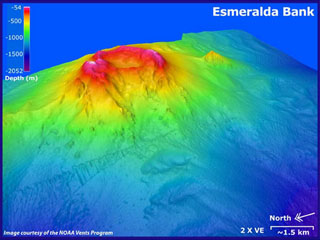Report on Esmeralda Bank (United States) — June 1982
Scientific Event Alert Network Bulletin, vol. 7, no. 6 (June 1982)
Managing Editor: Lindsay McClelland.
Esmeralda Bank (United States) Submarine sulfur emission
Please cite this report as:
Global Volcanism Program, 1982. Report on Esmeralda Bank (United States) (McClelland, L., ed.). Scientific Event Alert Network Bulletin, 7:6. Smithsonian Institution. https://doi.org/10.5479/si.GVP.SEAN198206-284210
Esmeralda Bank
United States
14.958°N, 145.249°E; summit elev. -74 m
All times are local (unless otherwise noted)
In April, "sulfur boil" activity was observed at the submarine volcano Esmeralda Bank from the U.S. National Marine Fisheries Service research vessel Townsend Cromwell. The sulfur emission can be seen as an area of strong mixing above the Bank on a 6 April bottom profile. The research vessel's log notes three sources of sulfur emission on 21 April, the strongest near a shoal at 50 m depth, a second S of a ridge just S of the main shoal, and the third in the saddle between these two shallow areas. The next day, the main source remained strongly active and emission continued from the saddle vent, but by 24 April sulfur emission was only barely visible.
Further Reference. Gorshkov, A.P., Gavrilenko, G.M., Seliverstov, N.I., and Scripko, K.A., 1982, Geologic Structure and fumarolic activity of the Esmeralda submarine volcano, in Schmincke, H.-U., Baker, P.E., and Forjaz, V.H. (eds.), Proceedings of the International Symposium on the Activity of Oceanic Volcanoes: Arquipélago, Serie Ciéncias da Natureza (Univ. Azores) no. 3, p. 271-298.
Geological Summary. Esmeralda Bank is a massive submarine volcano with three cones oriented N-S over about 15 km. The high points on the crater rim of the large middle edifice, with a collapse scarp open to the W, are about 75 m below the ocean surface. Frequent sulfur-rich surface bubbling and water discoloration have been observed, which have variously been attributed to eruptive events or fumarolic activity.
Information Contacts: L. Eldredge, Univ. of Guam.

